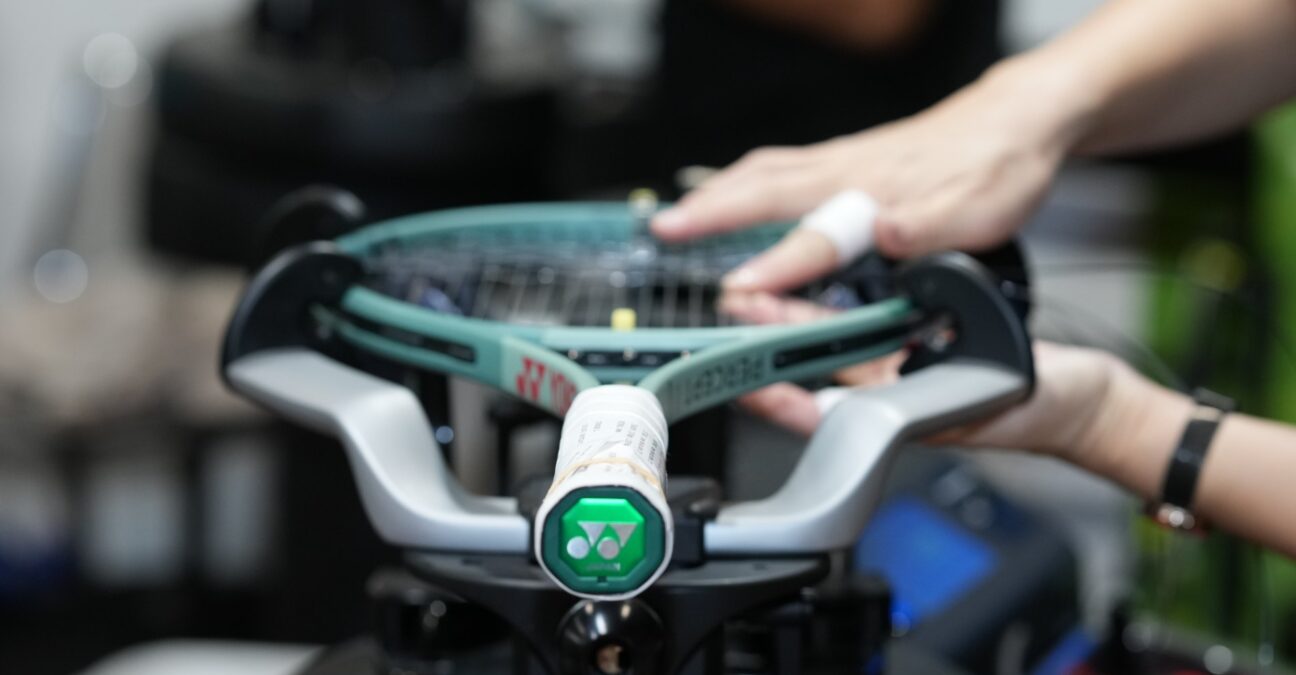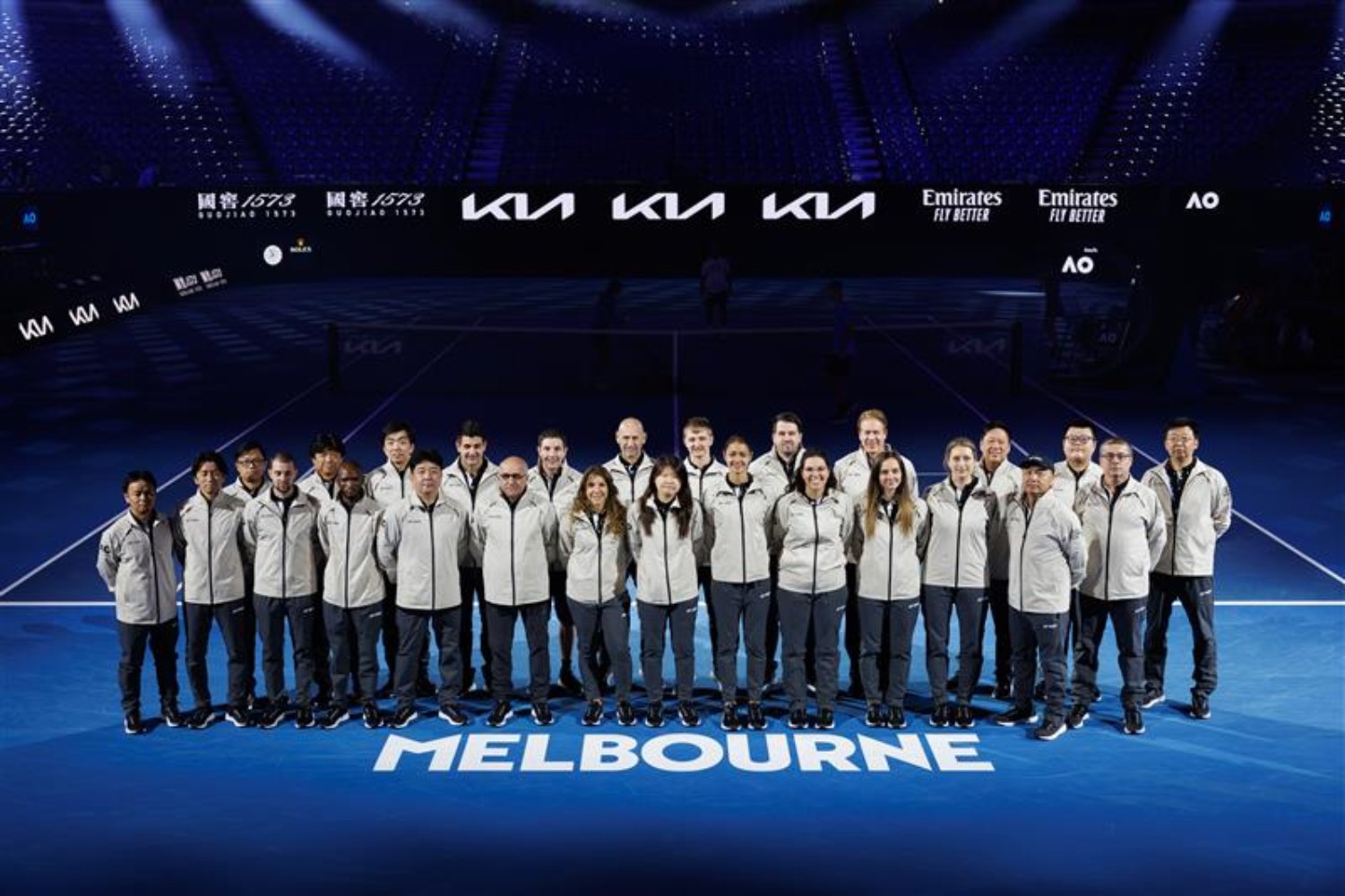Inside a stringer’s world: From Mannarino at 10kgs to extremes of 40kgs
According to Jim Downes, the head of the Yonex Stringing Team at the Australian Open, players are increasingly asking for racquets to be strung at lower tensions, to prevent injury
 @ Yonex
@ Yonex
Anyone who has ever been to a tennis tournament will undoubtedly have seen the stringers, the men and women beavering away behind the scenes looking after the most important object in a player’s arsenal; the racquet.
Usually you can only see them through a window but Tennis Majors had the opportunity to go behind the scenes to see the Yonex Stringing Team at the Australian Open, a team that midway through day five had already restrung more than 5,000 racquets and by the end of this fortnight, are expected to have topped 7,000, if not 8,000.
Buried underground in a room about 200 yards along from the player locker rooms at Melbourne Park, the Yonex stringing team begin work at about 7am each day and most have not been able to leave before 9pm any day so far, such are the demands for their expertise. A couple of people stay right to the end every night, just in case they are called upon by one of the players still on court.
Jim Downes, the head stringer in the room, makes sure the workload is spread evenly. “It’s a lot of racquets, and it’s a challenging job because we never know how many racquets a player will drop for a match, or how the draw is going to play out in the schedule,” he said. “So some stringers end up overwhelmed, because sometimes players drop six for their match. So I’m just trying to balance things out as I can keep things fair for everybody, so nobody’s working a lot harder than the other.”
Mannarino strings his racquet at 10kgs
Stringing racquets is something of a science, from the kind of string used to the tension the players ask for. Interestingly, there is a wide variety of tensions and though there is a policy on Tour of not publicising individual players’ string tensions, it’s widely known that Frenchman Adrian Mannarino has the lowest-strung racquet, at a quite ridiculous 22lbs, or 10kgs.
For those not used to these numbers, 10kgs is ridiculously low, making the strings almost like a trampoline. The lower the tension, the more power a player gets, while tighter strings give more control. The ball retains its shape more with looser strings, so the momentum is maintained, while when the strings are tight, the ball is crushed more on the strings and loses some of its energy, and therefore power. You will hear people talk of players “holding the ball on the strings” when they are exercising control.
“(The tensions) are all over the place,” Downes says. “I do work at a shop part time when I am home, and a lot of the customers come in and say, well, what’s the best string? What’s the best tension for my racket? There is no true answer to that. It’s all so individual. We have one player in the room that does about 22 pounds, and we have another player, a female player who wants 88 pounds.
Though Downes would not give out names, he said the woman who uses 88 would probably go even higher if she could. “I’ve watched the girl with 88 pounds play and she gives it everything and the ball doesn’t really come off her racquet very well. But I think she wants to go as high as the machine will go. Most machines are in the high 80s as their max. I think if a machine went to 100 maybe she’d ask for 100.”

Trend is toward lower string tensions to prevent injury
As tennis has become more physical, we are seeing more and more injuries. As a result, Downes says, players are beginning to go down in tension, looking for a little less impact on the arm.
“We have seen a trend in lower tensions over the years,” he said. “A lot of players, the male players, used to be around low 50s when I first started, and now they’re trending down into the high 40s, mid 40s, and even some in the 30s. The women used to be closer to 60, and they’re pulling back to the mid 50s, low 50s.”
The kind of string used also varies, he said. ” We have seen a trend with more players trying hybrid setups to get the benefits of two different strings, especially natural gut,” he said. “We’ve seen a lot more natural gut hybrids. I think players train so hard and play so much, they’re just starting to develop issues with their arms and shoulders.”
Young players tend to migrate to gut-cross strings as they age, the impact on the arm causing them to look for some comfort. “We see a lot of that once they start developing issues,” he said. “They think, what can they do? The first step is to try gut. Some players have issues controlling the ball when they first switch to gut so they adjust tension accordingly, or just manage to change their swing to keep the ball in.”
Yonex string for majority of players, including Sinner
While many of the top players have their own private stringer, Yonex are stringing for the “majority” of players at the Australian Open this year, including some big names. “There’s still some top players that use our service. We have (Jannik) Sinner in the room, (Alexander) Zverev is in the room as well this year. He used to be private but he’s decided to use us this year.”
Many players these days change their racquets at every ball change and many need racquets strung during matches. It could be a change in conditions that requires the restring, or they don’t like the ones they began with. ‘On-courts’ are becoming more prevalent with every passing year.
“There seem to be more and more,” Downes said. “A couple of days ago, we had probably six on-courts in the room at the same time. We probably do close to 50 on-courts in a day. So it’s becoming more common, I think, that the player sends a racquet off.”
Stringing a racquet in seven minutes
For the less experienced stringer, knowing they are working on the racquet of a top player can be stressful but for Downes, it’s water off a duck’s back. “I remember my first couple years, it was exciting to string for top players,” he said. “But I’ve done about 80 tournaments now, and at this point, whether it’s a hitting partner or Sinner it’s just a racquet.”
There are occasional complaints, mostly about racquets losing tension, which Downes said is impossible to explain. “Maybe it’s in their heads,” he said. His personal record for stringing a racquet is seven minutes, though he admits it was the most basic racquet and string pattern. Usually, his team aim to string three per hour, so 20 minutes per racquet, but when they are doing “on-courts” it is closer to 15.
You might think there is a lot of stress in the room, given the importance of the job and the emphasis on speed, but Downes said he works hard to ensure everyone gets enough breaks and is not overloaded.
“A lot of stringers get deflated when they see a lot of racquets coming to their box. And of course, there’s time limits on a lot of things. Usually early in the morning we get a lot of last-minute (requests). We try to squeeze in what we can. Once you’ve done as many racquets as these guys, you don’t have to think about it. Put headphones on and just wander off into the zone.”










